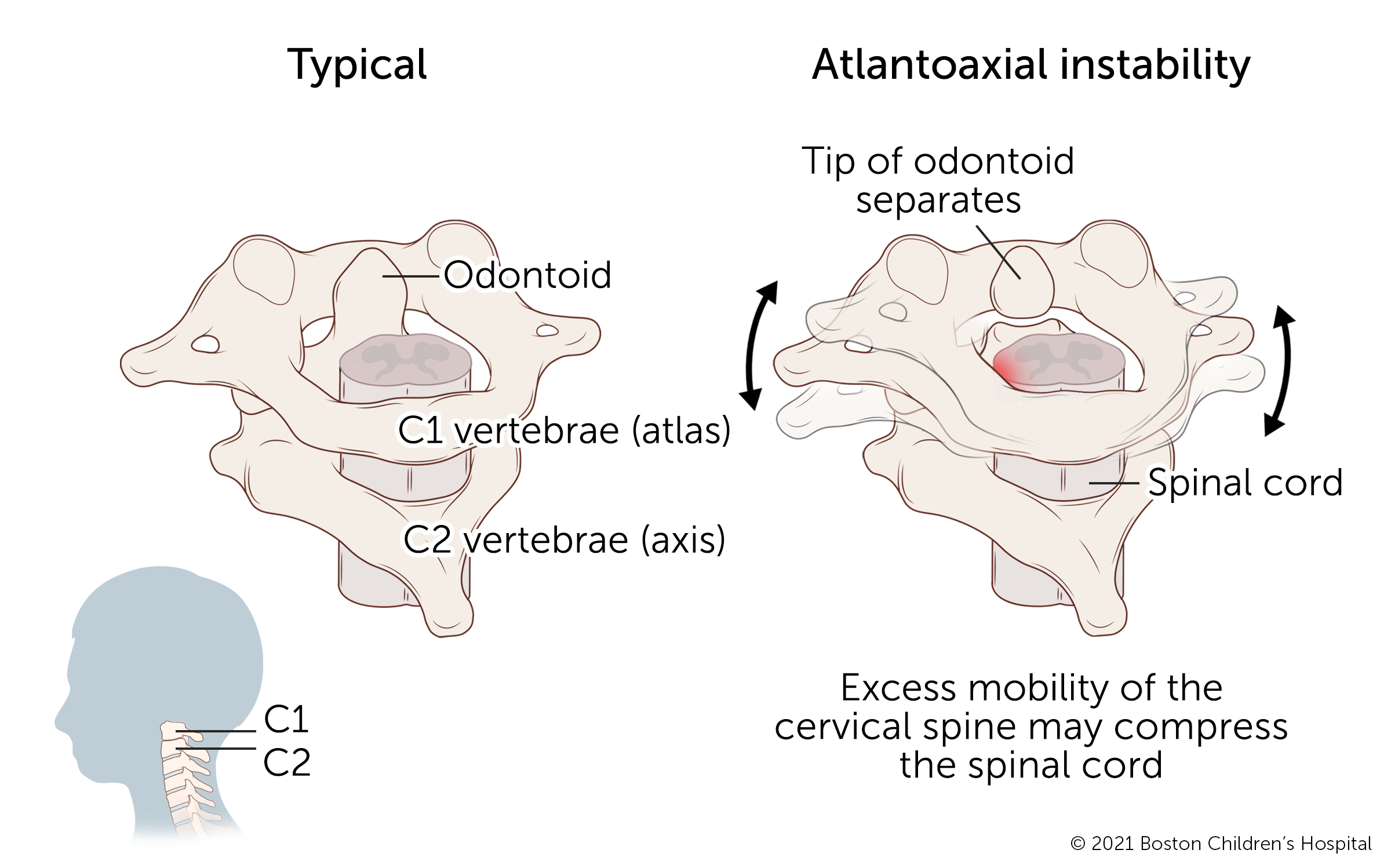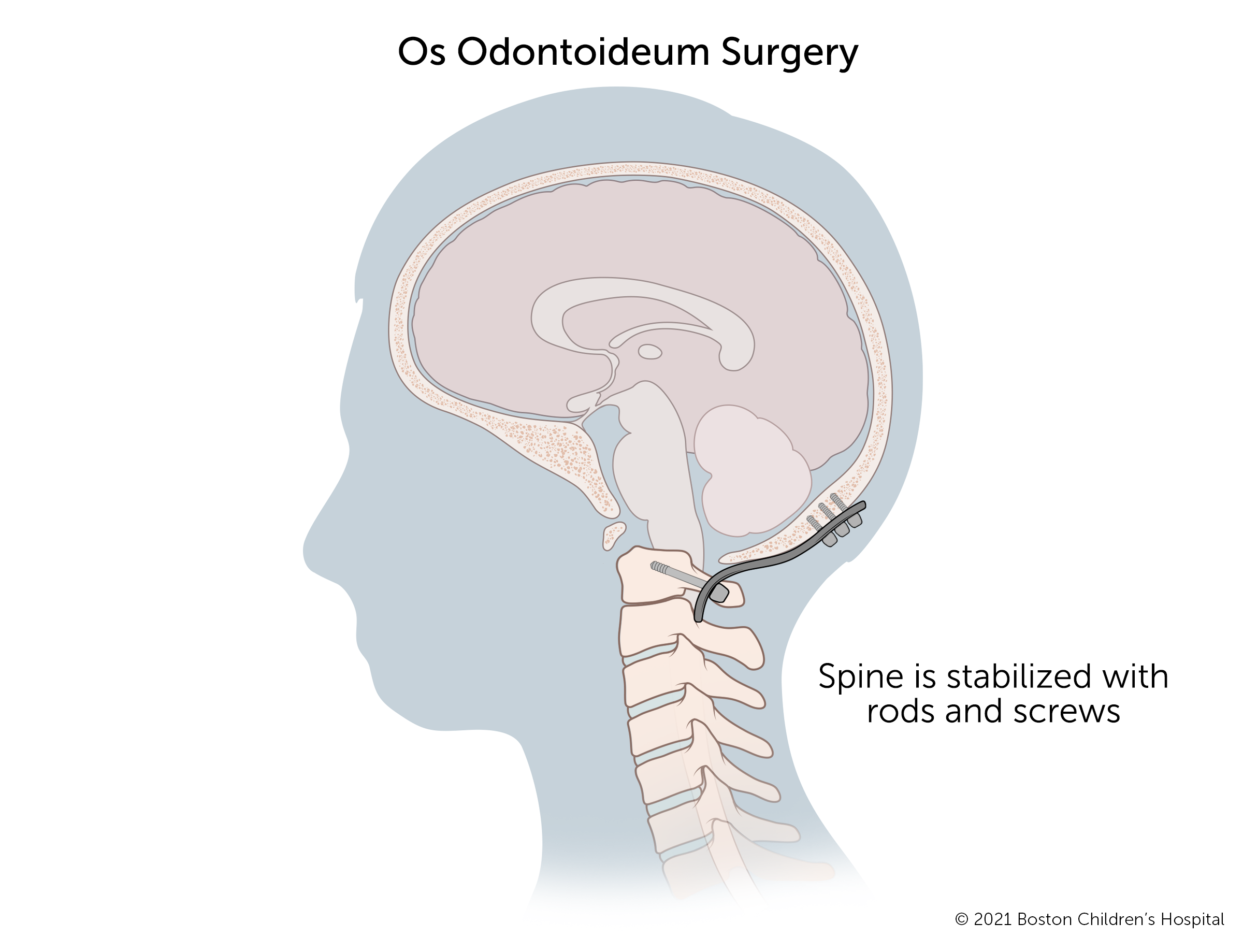What is os odontoideum?
Os odontoideum is a rare condition of the cervical spine. It occurs when a separation occurs at the top of the spine. The tip of the second cervical vertebra is called the odontoid. In os odontoideum, the tip of the odontoid becomes separated from the remainder of the vertebra, which can lead to spinal instability.

Some children with os odontoideum have no symptoms. In others, the condition causes instability in the joint that connects the spine to the base of the skull. In severe cases, the neck becomes overly mobile and can compress the spinal cord. Some children with os odontoideum develop atlantoaxial instability, a more serious form of excess mobility in the cervical spine. In such cases, surgery is almost always necessary to prevent long-term nerve damage and paralysis.
Whether their condition is mild or severe, children with os odontoideum should avoid contact sports, such as hockey or football, as even a small injury can cause serious harm.
Os odontoideum and the anatomy of the spine
The spine is made up of disk-shaped bones called vertebrae. The vertebrae are stacked on top of each other. Together, they support the upper body and protect the spinal cord.
The neck, also known as the cervical spine, is made up of seven vertebrae. The two at the top, known as C1 and C2, are connected by a nob that makes it possible to move the head in various directions. This nob is called the “dens” or “odontoid process.” In os odontoideum, a piece of the dens separates from the C2 vertebra.
What are the symptoms of os odontoideum?
Symptoms of os odontoideum depend on the type and severity of the condition but may include:
- neck pain
- abnormal head and neck posture
- headaches
- neurovascular symptoms such as numbness or weakness on one side of the body or loss of balance
If a child’s cervical spine is severely unstable and compresses the spinal cord, the child will have more serious symptoms that may include:
- temporary paralysis
- lost coordination
- trouble grasping or holding objects
- unsteady walking or crawling
- impaired vision
- hearing problems
- fainting
- severe headache
What causes os odontoideum?
Doctors do not know for sure what causes os odontoideum. It appears that some children are born with the condition. However, researchers believe that trauma from an accident or fall is responsible for most cases.
Certain conditions increase a child’s risk of os odontoideum, including:
- Down syndrome
- Klippel-Feil syndrome
- Morquoi syndrome
- congenital abnormalities of the cranium and cervical spine
How is os odontoideum diagnosed?
Because it is a rare disease that produces different symptoms in different children, os odontoideum is difficult to diagnose. Ideally, an orthopedic or neurological specialist will be involved in the diagnosis.
The doctor will review your child’s health history and symptoms and conduct a thorough exam of their neck and spine. They will also evaluate your child’s pain, range of motion, and any possible effects on your child’s development, movement, or coordination.
The following imaging studies also help diagnose os odontoideum:
- computed tomography (CT scans) provide detailed pictures of the vertebrae in the neck to identify signs of fracture
- magnetic resonance imaging (MRIs) provide images of tissues and structures around the cervical spine to help doctors look for signs of damage
How is os odontoideum treated?
While some children with os odontoideum can be treated without surgery, the condition often requires surgery.
Non-surgical os odontoideum treatment
Children with mild os odontoideum may not need surgery. They should see a spine specialist regularly to monitor their spine over time and watch for any signs of progression or spinal cord damage. Physical therapy, a cervical collar, or pain medication may be prescribed to control symptoms.
Surgical os odontoideum treatment
Research conducted at Boston Children’s and other spine centers have shown that delaying surgery for os odontoideum can increase a child’s risk of spinal cord injury and neurological impairment. In particular, if a child has neurological problems, such as lost coordination or mobility, surgery is necessary to stabilize the spine and prevent long-term damage.

Because os odontoideum involves the spinal cord and the spine, the surgical team should include specialists in neurosurgery and spine surgery. The neurosurgeon will decompress the spinal cord and reposition the bone so it no longer presses against the spine. The spine surgeon will then stabilize the spine with rods and screws. Over time, with the help of bone grafts packed around the damaged vertebrae during surgery, the affected section of spine will heal into solid bone.
How we care for os odontoideum at Boston Children’s Hospital
The Complex Cervical Spine Program at Boston Children’s Hospital is the first and only multidisciplinary pediatric cervical spine clinic in the United States. Our team includes specialists in neurology, neurosurgery, and orthopedic surgery experienced in correcting rare and complicated cervical spine disorders like os odontoideum. Our ongoing research advances the treatment with rare disorders of the cervical spine. Combined with the world-class expertise at Boston Children’s, our culture of collaboration enables us to treat the most complex cases and perform the most delicate surgeries to help our patients to lead full, independent lives.
Os Odontoideum | Programs & Services
Programs
Complex Cervical Spine Program
Program
The Complex Cervical Spine Program offers compassionate pediatric care and surgical expertise for infants, children, and teens. Learn more.
Departments
Neurology
Department
The Department of Neurology cares for infants, children, and adolescents with all types of neurologic and developmental disorders.
Neurosurgery
Department
The Department of Neurosurgery serves children with disorders of the brain, spine, and nervous system.
Centers
Orthopedic Center
Center
Established in 1903, we are one of the world’s most experienced pediatric orthopedic centers. Learn more.


